Environmental Science Case Study: Great Barrier Reef Tourism Impacts
VerifiedAdded on 2021/02/20
|9
|2987
|148
Case Study
AI Summary
This case study examines the impact of tourism on the Great Barrier Reef and evaluates various strategies for sustainable management. The study delves into tourism planning, including zoning regulations and codes of conduct, and explores marketing strategies and technology, such as the use of ...
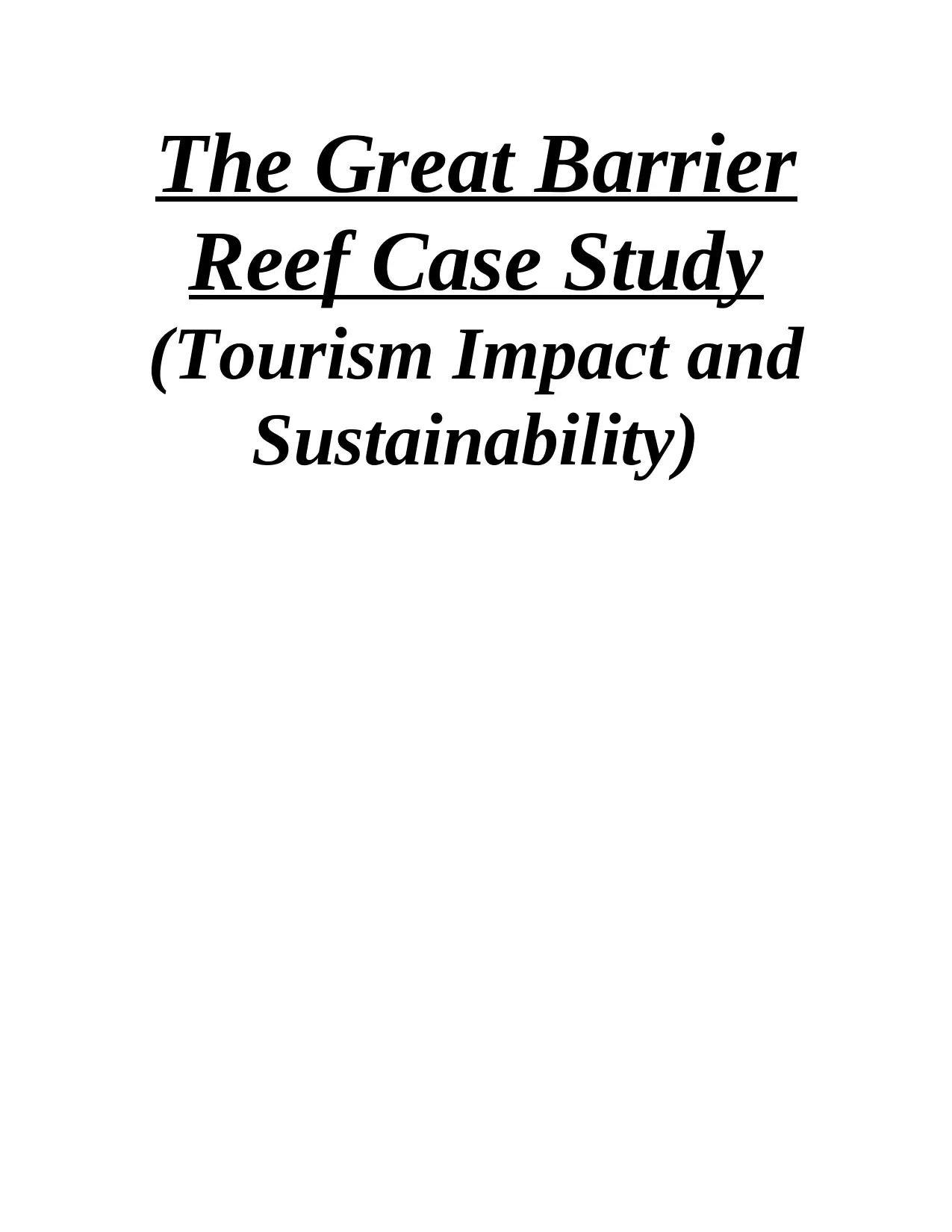
The Great Barrier
Reef Case Study
(Tourism Impact and
Sustainability)
Reef Case Study
(Tourism Impact and
Sustainability)
Secure Best Marks with AI Grader
Need help grading? Try our AI Grader for instant feedback on your assignments.
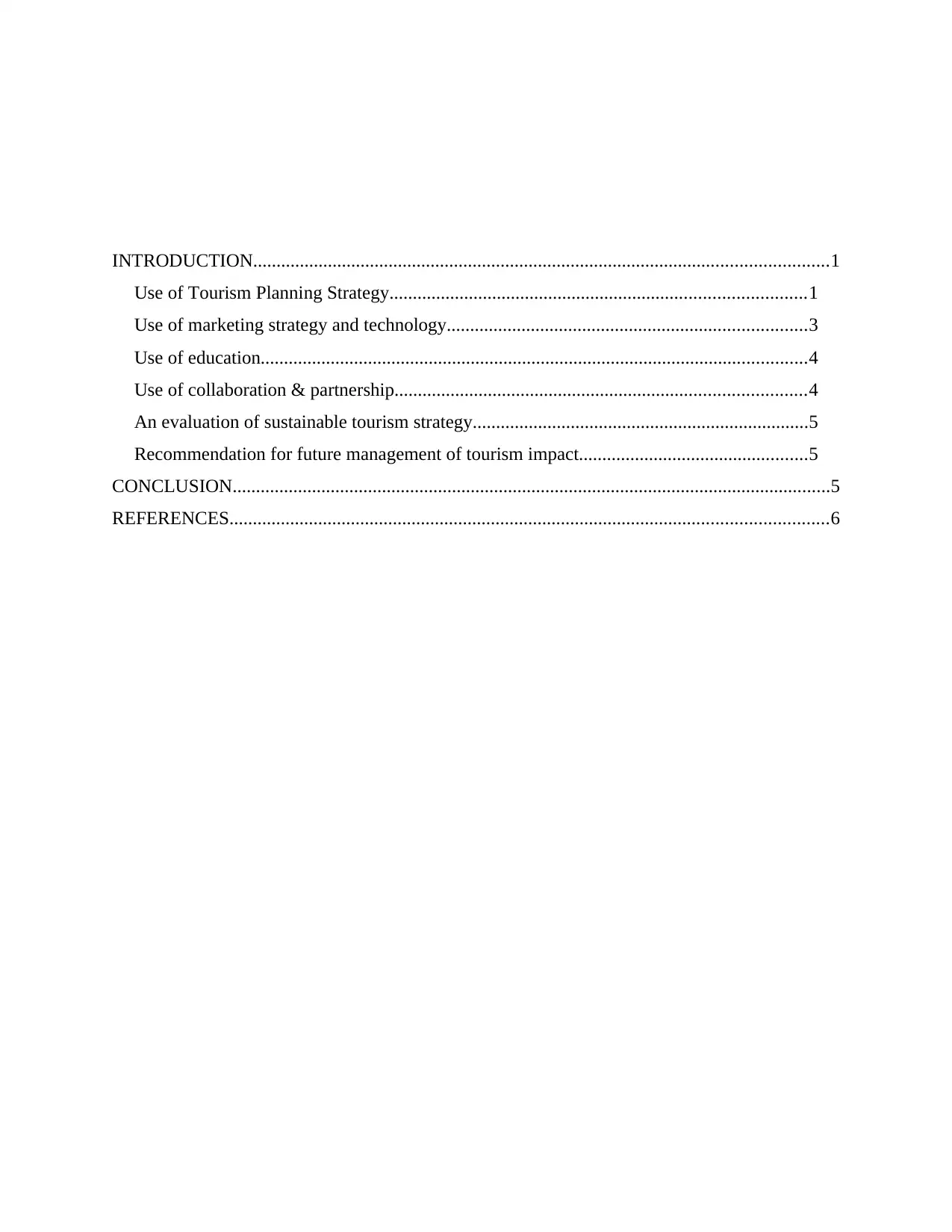
INTRODUCTION...........................................................................................................................1
Use of Tourism Planning Strategy.........................................................................................1
Use of marketing strategy and technology.............................................................................3
Use of education.....................................................................................................................4
Use of collaboration & partnership........................................................................................4
An evaluation of sustainable tourism strategy........................................................................5
Recommendation for future management of tourism impact.................................................5
CONCLUSION................................................................................................................................5
REFERENCES................................................................................................................................6
Use of Tourism Planning Strategy.........................................................................................1
Use of marketing strategy and technology.............................................................................3
Use of education.....................................................................................................................4
Use of collaboration & partnership........................................................................................4
An evaluation of sustainable tourism strategy........................................................................5
Recommendation for future management of tourism impact.................................................5
CONCLUSION................................................................................................................................5
REFERENCES................................................................................................................................6
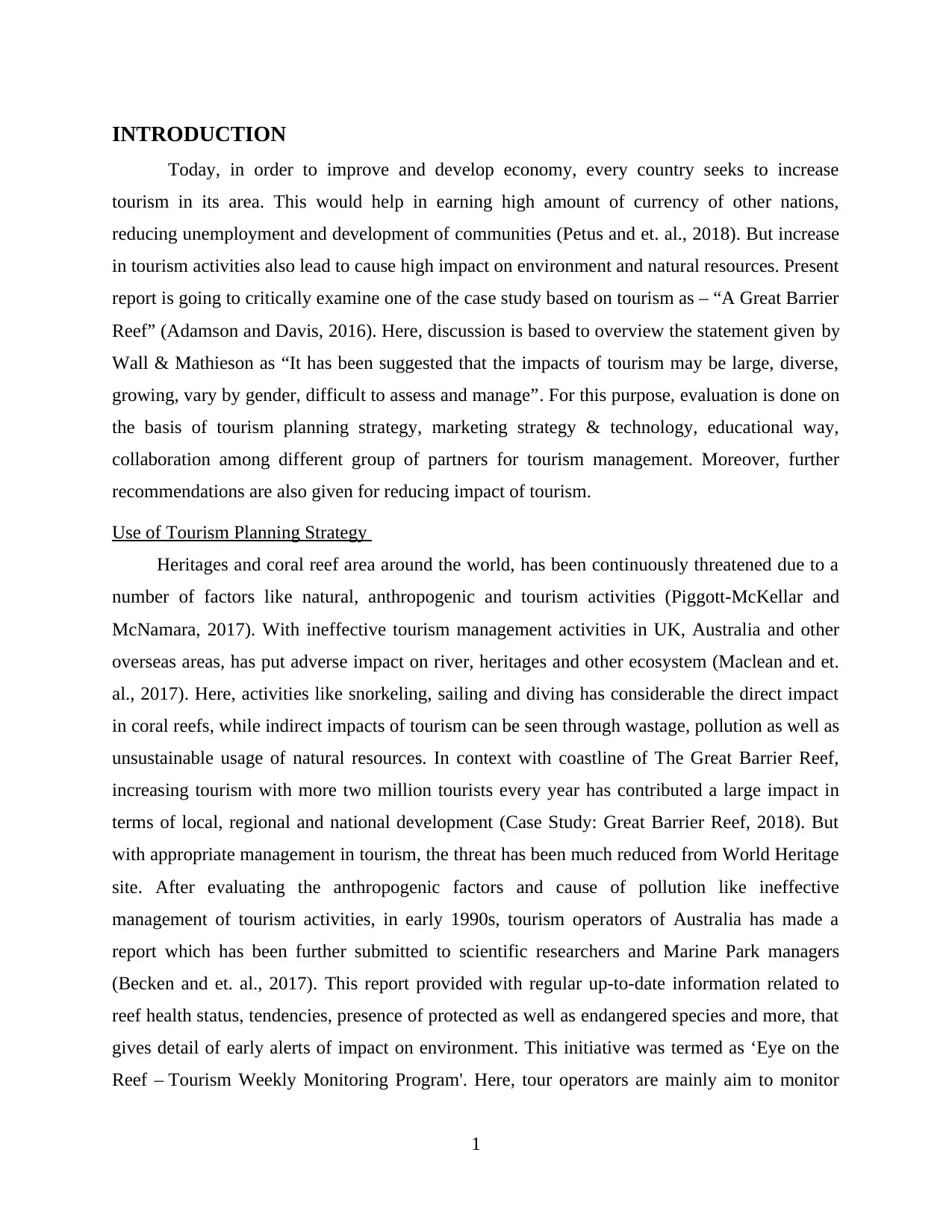
INTRODUCTION
Today, in order to improve and develop economy, every country seeks to increase
tourism in its area. This would help in earning high amount of currency of other nations,
reducing unemployment and development of communities (Petus and et. al., 2018). But increase
in tourism activities also lead to cause high impact on environment and natural resources. Present
report is going to critically examine one of the case study based on tourism as – “A Great Barrier
Reef” (Adamson and Davis, 2016). Here, discussion is based to overview the statement given by
Wall & Mathieson as “It has been suggested that the impacts of tourism may be large, diverse,
growing, vary by gender, difficult to assess and manage”. For this purpose, evaluation is done on
the basis of tourism planning strategy, marketing strategy & technology, educational way,
collaboration among different group of partners for tourism management. Moreover, further
recommendations are also given for reducing impact of tourism.
Use of Tourism Planning Strategy
Heritages and coral reef area around the world, has been continuously threatened due to a
number of factors like natural, anthropogenic and tourism activities (Piggott-McKellar and
McNamara, 2017). With ineffective tourism management activities in UK, Australia and other
overseas areas, has put adverse impact on river, heritages and other ecosystem (Maclean and et.
al., 2017). Here, activities like snorkeling, sailing and diving has considerable the direct impact
in coral reefs, while indirect impacts of tourism can be seen through wastage, pollution as well as
unsustainable usage of natural resources. In context with coastline of The Great Barrier Reef,
increasing tourism with more two million tourists every year has contributed a large impact in
terms of local, regional and national development (Case Study: Great Barrier Reef, 2018). But
with appropriate management in tourism, the threat has been much reduced from World Heritage
site. After evaluating the anthropogenic factors and cause of pollution like ineffective
management of tourism activities, in early 1990s, tourism operators of Australia has made a
report which has been further submitted to scientific researchers and Marine Park managers
(Becken and et. al., 2017). This report provided with regular up-to-date information related to
reef health status, tendencies, presence of protected as well as endangered species and more, that
gives detail of early alerts of impact on environment. This initiative was termed as ‘Eye on the
Reef – Tourism Weekly Monitoring Program'. Here, tour operators are mainly aim to monitor
1
Today, in order to improve and develop economy, every country seeks to increase
tourism in its area. This would help in earning high amount of currency of other nations,
reducing unemployment and development of communities (Petus and et. al., 2018). But increase
in tourism activities also lead to cause high impact on environment and natural resources. Present
report is going to critically examine one of the case study based on tourism as – “A Great Barrier
Reef” (Adamson and Davis, 2016). Here, discussion is based to overview the statement given by
Wall & Mathieson as “It has been suggested that the impacts of tourism may be large, diverse,
growing, vary by gender, difficult to assess and manage”. For this purpose, evaluation is done on
the basis of tourism planning strategy, marketing strategy & technology, educational way,
collaboration among different group of partners for tourism management. Moreover, further
recommendations are also given for reducing impact of tourism.
Use of Tourism Planning Strategy
Heritages and coral reef area around the world, has been continuously threatened due to a
number of factors like natural, anthropogenic and tourism activities (Piggott-McKellar and
McNamara, 2017). With ineffective tourism management activities in UK, Australia and other
overseas areas, has put adverse impact on river, heritages and other ecosystem (Maclean and et.
al., 2017). Here, activities like snorkeling, sailing and diving has considerable the direct impact
in coral reefs, while indirect impacts of tourism can be seen through wastage, pollution as well as
unsustainable usage of natural resources. In context with coastline of The Great Barrier Reef,
increasing tourism with more two million tourists every year has contributed a large impact in
terms of local, regional and national development (Case Study: Great Barrier Reef, 2018). But
with appropriate management in tourism, the threat has been much reduced from World Heritage
site. After evaluating the anthropogenic factors and cause of pollution like ineffective
management of tourism activities, in early 1990s, tourism operators of Australia has made a
report which has been further submitted to scientific researchers and Marine Park managers
(Becken and et. al., 2017). This report provided with regular up-to-date information related to
reef health status, tendencies, presence of protected as well as endangered species and more, that
gives detail of early alerts of impact on environment. This initiative was termed as ‘Eye on the
Reef – Tourism Weekly Monitoring Program'. Here, tour operators are mainly aim to monitor
1
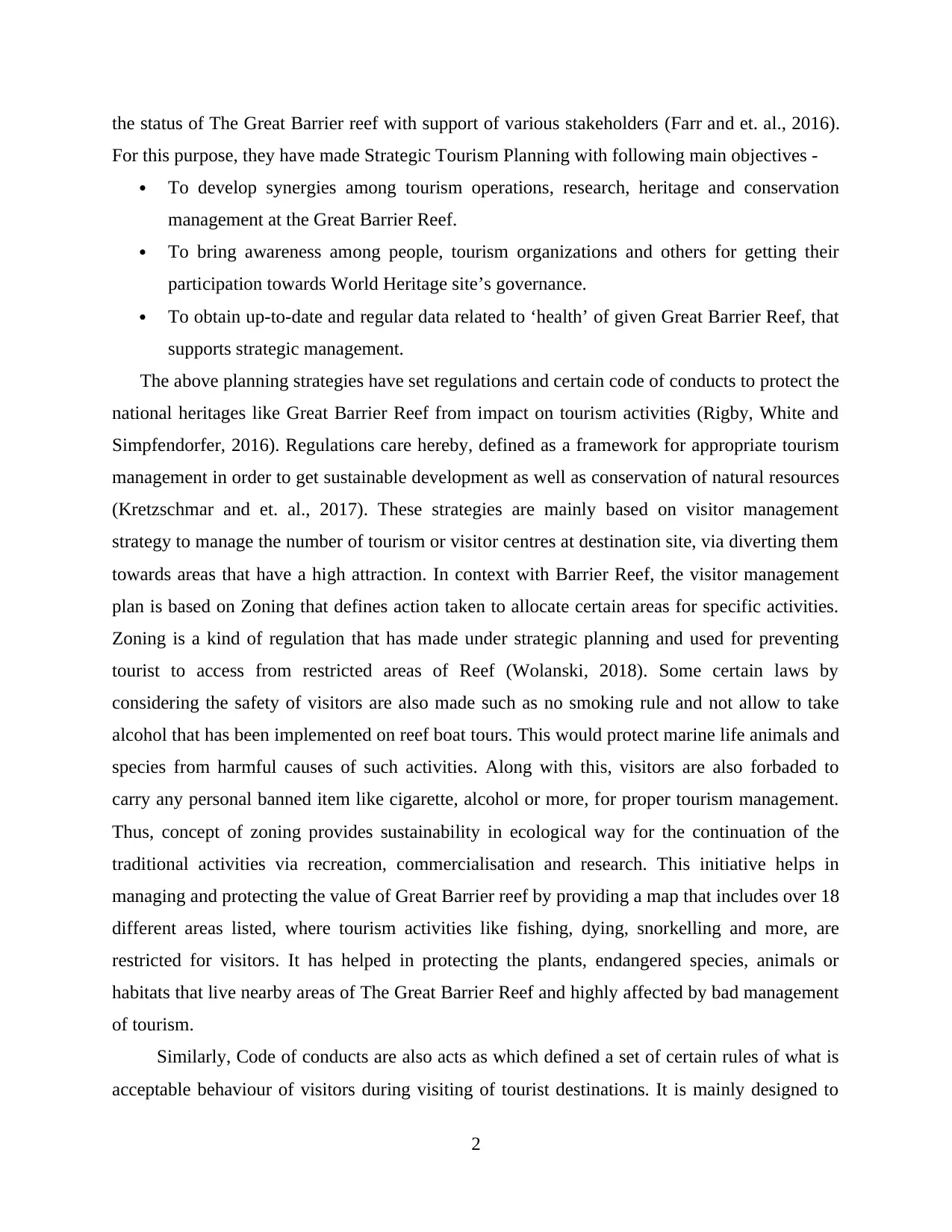
the status of The Great Barrier reef with support of various stakeholders (Farr and et. al., 2016).
For this purpose, they have made Strategic Tourism Planning with following main objectives -
To develop synergies among tourism operations, research, heritage and conservation
management at the Great Barrier Reef.
To bring awareness among people, tourism organizations and others for getting their
participation towards World Heritage site’s governance.
To obtain up-to-date and regular data related to ‘health’ of given Great Barrier Reef, that
supports strategic management.
The above planning strategies have set regulations and certain code of conducts to protect the
national heritages like Great Barrier Reef from impact on tourism activities (Rigby, White and
Simpfendorfer, 2016). Regulations care hereby, defined as a framework for appropriate tourism
management in order to get sustainable development as well as conservation of natural resources
(Kretzschmar and et. al., 2017). These strategies are mainly based on visitor management
strategy to manage the number of tourism or visitor centres at destination site, via diverting them
towards areas that have a high attraction. In context with Barrier Reef, the visitor management
plan is based on Zoning that defines action taken to allocate certain areas for specific activities.
Zoning is a kind of regulation that has made under strategic planning and used for preventing
tourist to access from restricted areas of Reef (Wolanski, 2018). Some certain laws by
considering the safety of visitors are also made such as no smoking rule and not allow to take
alcohol that has been implemented on reef boat tours. This would protect marine life animals and
species from harmful causes of such activities. Along with this, visitors are also forbaded to
carry any personal banned item like cigarette, alcohol or more, for proper tourism management.
Thus, concept of zoning provides sustainability in ecological way for the continuation of the
traditional activities via recreation, commercialisation and research. This initiative helps in
managing and protecting the value of Great Barrier reef by providing a map that includes over 18
different areas listed, where tourism activities like fishing, dying, snorkelling and more, are
restricted for visitors. It has helped in protecting the plants, endangered species, animals or
habitats that live nearby areas of The Great Barrier Reef and highly affected by bad management
of tourism.
Similarly, Code of conducts are also acts as which defined a set of certain rules of what is
acceptable behaviour of visitors during visiting of tourist destinations. It is mainly designed to
2
For this purpose, they have made Strategic Tourism Planning with following main objectives -
To develop synergies among tourism operations, research, heritage and conservation
management at the Great Barrier Reef.
To bring awareness among people, tourism organizations and others for getting their
participation towards World Heritage site’s governance.
To obtain up-to-date and regular data related to ‘health’ of given Great Barrier Reef, that
supports strategic management.
The above planning strategies have set regulations and certain code of conducts to protect the
national heritages like Great Barrier Reef from impact on tourism activities (Rigby, White and
Simpfendorfer, 2016). Regulations care hereby, defined as a framework for appropriate tourism
management in order to get sustainable development as well as conservation of natural resources
(Kretzschmar and et. al., 2017). These strategies are mainly based on visitor management
strategy to manage the number of tourism or visitor centres at destination site, via diverting them
towards areas that have a high attraction. In context with Barrier Reef, the visitor management
plan is based on Zoning that defines action taken to allocate certain areas for specific activities.
Zoning is a kind of regulation that has made under strategic planning and used for preventing
tourist to access from restricted areas of Reef (Wolanski, 2018). Some certain laws by
considering the safety of visitors are also made such as no smoking rule and not allow to take
alcohol that has been implemented on reef boat tours. This would protect marine life animals and
species from harmful causes of such activities. Along with this, visitors are also forbaded to
carry any personal banned item like cigarette, alcohol or more, for proper tourism management.
Thus, concept of zoning provides sustainability in ecological way for the continuation of the
traditional activities via recreation, commercialisation and research. This initiative helps in
managing and protecting the value of Great Barrier reef by providing a map that includes over 18
different areas listed, where tourism activities like fishing, dying, snorkelling and more, are
restricted for visitors. It has helped in protecting the plants, endangered species, animals or
habitats that live nearby areas of The Great Barrier Reef and highly affected by bad management
of tourism.
Similarly, Code of conducts are also acts as which defined a set of certain rules of what is
acceptable behaviour of visitors during visiting of tourist destinations. It is mainly designed to
2
Secure Best Marks with AI Grader
Need help grading? Try our AI Grader for instant feedback on your assignments.
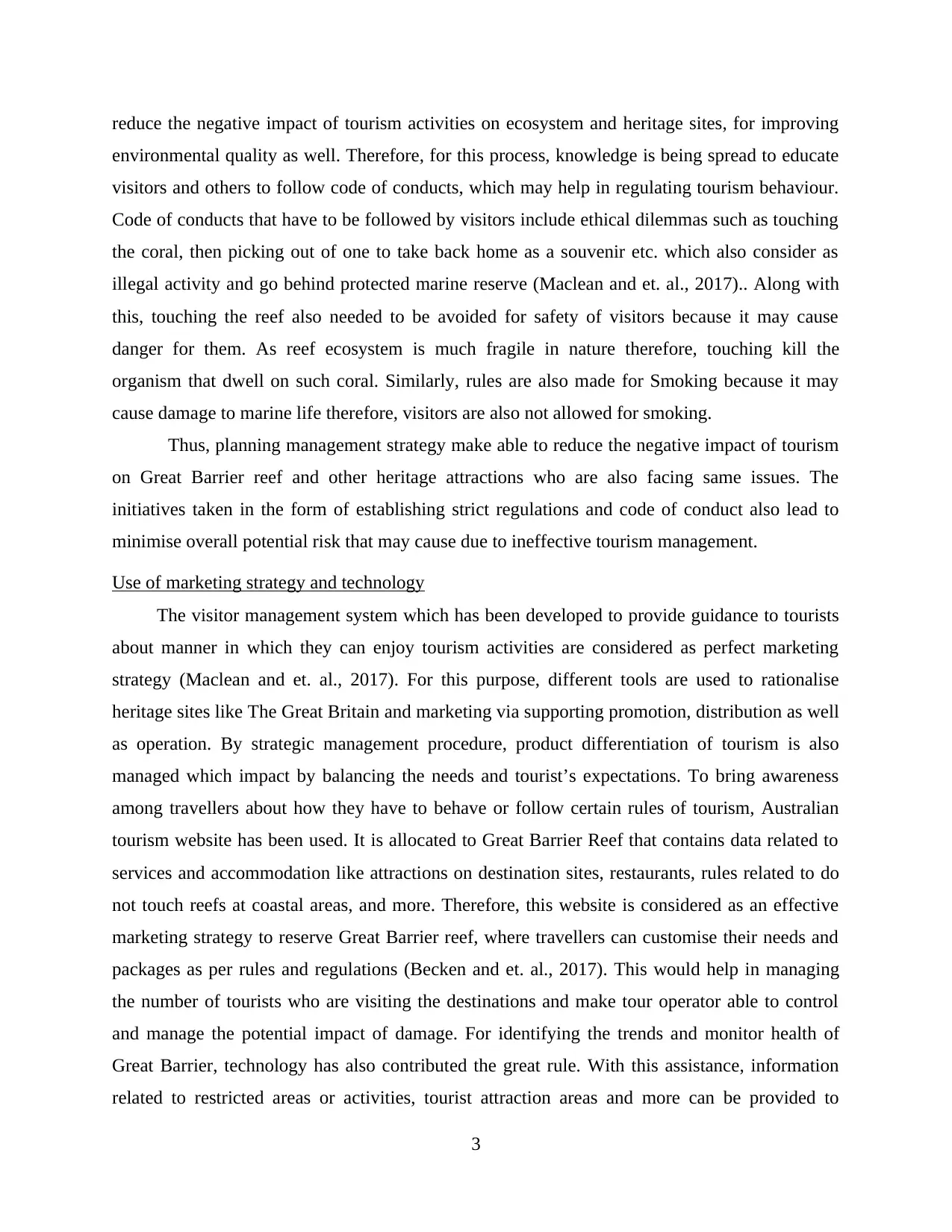
reduce the negative impact of tourism activities on ecosystem and heritage sites, for improving
environmental quality as well. Therefore, for this process, knowledge is being spread to educate
visitors and others to follow code of conducts, which may help in regulating tourism behaviour.
Code of conducts that have to be followed by visitors include ethical dilemmas such as touching
the coral, then picking out of one to take back home as a souvenir etc. which also consider as
illegal activity and go behind protected marine reserve (Maclean and et. al., 2017).. Along with
this, touching the reef also needed to be avoided for safety of visitors because it may cause
danger for them. As reef ecosystem is much fragile in nature therefore, touching kill the
organism that dwell on such coral. Similarly, rules are also made for Smoking because it may
cause damage to marine life therefore, visitors are also not allowed for smoking.
Thus, planning management strategy make able to reduce the negative impact of tourism
on Great Barrier reef and other heritage attractions who are also facing same issues. The
initiatives taken in the form of establishing strict regulations and code of conduct also lead to
minimise overall potential risk that may cause due to ineffective tourism management.
Use of marketing strategy and technology
The visitor management system which has been developed to provide guidance to tourists
about manner in which they can enjoy tourism activities are considered as perfect marketing
strategy (Maclean and et. al., 2017). For this purpose, different tools are used to rationalise
heritage sites like The Great Britain and marketing via supporting promotion, distribution as well
as operation. By strategic management procedure, product differentiation of tourism is also
managed which impact by balancing the needs and tourist’s expectations. To bring awareness
among travellers about how they have to behave or follow certain rules of tourism, Australian
tourism website has been used. It is allocated to Great Barrier Reef that contains data related to
services and accommodation like attractions on destination sites, restaurants, rules related to do
not touch reefs at coastal areas, and more. Therefore, this website is considered as an effective
marketing strategy to reserve Great Barrier reef, where travellers can customise their needs and
packages as per rules and regulations (Becken and et. al., 2017). This would help in managing
the number of tourists who are visiting the destinations and make tour operator able to control
and manage the potential impact of damage. For identifying the trends and monitor health of
Great Barrier, technology has also contributed the great rule. With this assistance, information
related to restricted areas or activities, tourist attraction areas and more can be provided to
3
environmental quality as well. Therefore, for this process, knowledge is being spread to educate
visitors and others to follow code of conducts, which may help in regulating tourism behaviour.
Code of conducts that have to be followed by visitors include ethical dilemmas such as touching
the coral, then picking out of one to take back home as a souvenir etc. which also consider as
illegal activity and go behind protected marine reserve (Maclean and et. al., 2017).. Along with
this, touching the reef also needed to be avoided for safety of visitors because it may cause
danger for them. As reef ecosystem is much fragile in nature therefore, touching kill the
organism that dwell on such coral. Similarly, rules are also made for Smoking because it may
cause damage to marine life therefore, visitors are also not allowed for smoking.
Thus, planning management strategy make able to reduce the negative impact of tourism
on Great Barrier reef and other heritage attractions who are also facing same issues. The
initiatives taken in the form of establishing strict regulations and code of conduct also lead to
minimise overall potential risk that may cause due to ineffective tourism management.
Use of marketing strategy and technology
The visitor management system which has been developed to provide guidance to tourists
about manner in which they can enjoy tourism activities are considered as perfect marketing
strategy (Maclean and et. al., 2017). For this purpose, different tools are used to rationalise
heritage sites like The Great Britain and marketing via supporting promotion, distribution as well
as operation. By strategic management procedure, product differentiation of tourism is also
managed which impact by balancing the needs and tourist’s expectations. To bring awareness
among travellers about how they have to behave or follow certain rules of tourism, Australian
tourism website has been used. It is allocated to Great Barrier Reef that contains data related to
services and accommodation like attractions on destination sites, restaurants, rules related to do
not touch reefs at coastal areas, and more. Therefore, this website is considered as an effective
marketing strategy to reserve Great Barrier reef, where travellers can customise their needs and
packages as per rules and regulations (Becken and et. al., 2017). This would help in managing
the number of tourists who are visiting the destinations and make tour operator able to control
and manage the potential impact of damage. For identifying the trends and monitor health of
Great Barrier, technology has also contributed the great rule. With this assistance, information
related to restricted areas or activities, tourist attraction areas and more can be provided to
3
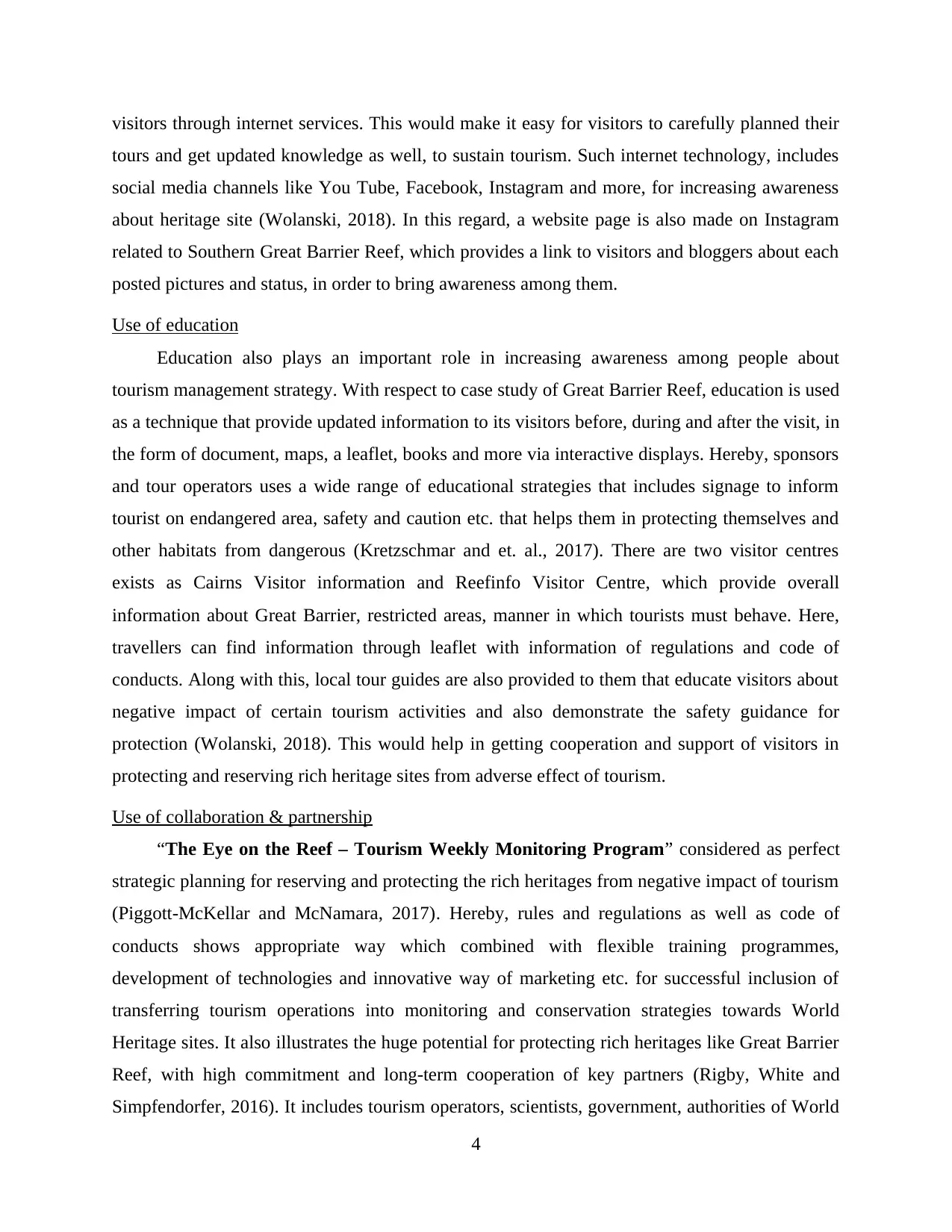
visitors through internet services. This would make it easy for visitors to carefully planned their
tours and get updated knowledge as well, to sustain tourism. Such internet technology, includes
social media channels like You Tube, Facebook, Instagram and more, for increasing awareness
about heritage site (Wolanski, 2018). In this regard, a website page is also made on Instagram
related to Southern Great Barrier Reef, which provides a link to visitors and bloggers about each
posted pictures and status, in order to bring awareness among them.
Use of education
Education also plays an important role in increasing awareness among people about
tourism management strategy. With respect to case study of Great Barrier Reef, education is used
as a technique that provide updated information to its visitors before, during and after the visit, in
the form of document, maps, a leaflet, books and more via interactive displays. Hereby, sponsors
and tour operators uses a wide range of educational strategies that includes signage to inform
tourist on endangered area, safety and caution etc. that helps them in protecting themselves and
other habitats from dangerous (Kretzschmar and et. al., 2017). There are two visitor centres
exists as Cairns Visitor information and Reefinfo Visitor Centre, which provide overall
information about Great Barrier, restricted areas, manner in which tourists must behave. Here,
travellers can find information through leaflet with information of regulations and code of
conducts. Along with this, local tour guides are also provided to them that educate visitors about
negative impact of certain tourism activities and also demonstrate the safety guidance for
protection (Wolanski, 2018). This would help in getting cooperation and support of visitors in
protecting and reserving rich heritage sites from adverse effect of tourism.
Use of collaboration & partnership
“The Eye on the Reef – Tourism Weekly Monitoring Program” considered as perfect
strategic planning for reserving and protecting the rich heritages from negative impact of tourism
(Piggott-McKellar and McNamara, 2017). Hereby, rules and regulations as well as code of
conducts shows appropriate way which combined with flexible training programmes,
development of technologies and innovative way of marketing etc. for successful inclusion of
transferring tourism operations into monitoring and conservation strategies towards World
Heritage sites. It also illustrates the huge potential for protecting rich heritages like Great Barrier
Reef, with high commitment and long-term cooperation of key partners (Rigby, White and
Simpfendorfer, 2016). It includes tourism operators, scientists, government, authorities of World
4
tours and get updated knowledge as well, to sustain tourism. Such internet technology, includes
social media channels like You Tube, Facebook, Instagram and more, for increasing awareness
about heritage site (Wolanski, 2018). In this regard, a website page is also made on Instagram
related to Southern Great Barrier Reef, which provides a link to visitors and bloggers about each
posted pictures and status, in order to bring awareness among them.
Use of education
Education also plays an important role in increasing awareness among people about
tourism management strategy. With respect to case study of Great Barrier Reef, education is used
as a technique that provide updated information to its visitors before, during and after the visit, in
the form of document, maps, a leaflet, books and more via interactive displays. Hereby, sponsors
and tour operators uses a wide range of educational strategies that includes signage to inform
tourist on endangered area, safety and caution etc. that helps them in protecting themselves and
other habitats from dangerous (Kretzschmar and et. al., 2017). There are two visitor centres
exists as Cairns Visitor information and Reefinfo Visitor Centre, which provide overall
information about Great Barrier, restricted areas, manner in which tourists must behave. Here,
travellers can find information through leaflet with information of regulations and code of
conducts. Along with this, local tour guides are also provided to them that educate visitors about
negative impact of certain tourism activities and also demonstrate the safety guidance for
protection (Wolanski, 2018). This would help in getting cooperation and support of visitors in
protecting and reserving rich heritage sites from adverse effect of tourism.
Use of collaboration & partnership
“The Eye on the Reef – Tourism Weekly Monitoring Program” considered as perfect
strategic planning for reserving and protecting the rich heritages from negative impact of tourism
(Piggott-McKellar and McNamara, 2017). Hereby, rules and regulations as well as code of
conducts shows appropriate way which combined with flexible training programmes,
development of technologies and innovative way of marketing etc. for successful inclusion of
transferring tourism operations into monitoring and conservation strategies towards World
Heritage sites. It also illustrates the huge potential for protecting rich heritages like Great Barrier
Reef, with high commitment and long-term cooperation of key partners (Rigby, White and
Simpfendorfer, 2016). It includes tourism operators, scientists, government, authorities of World
4
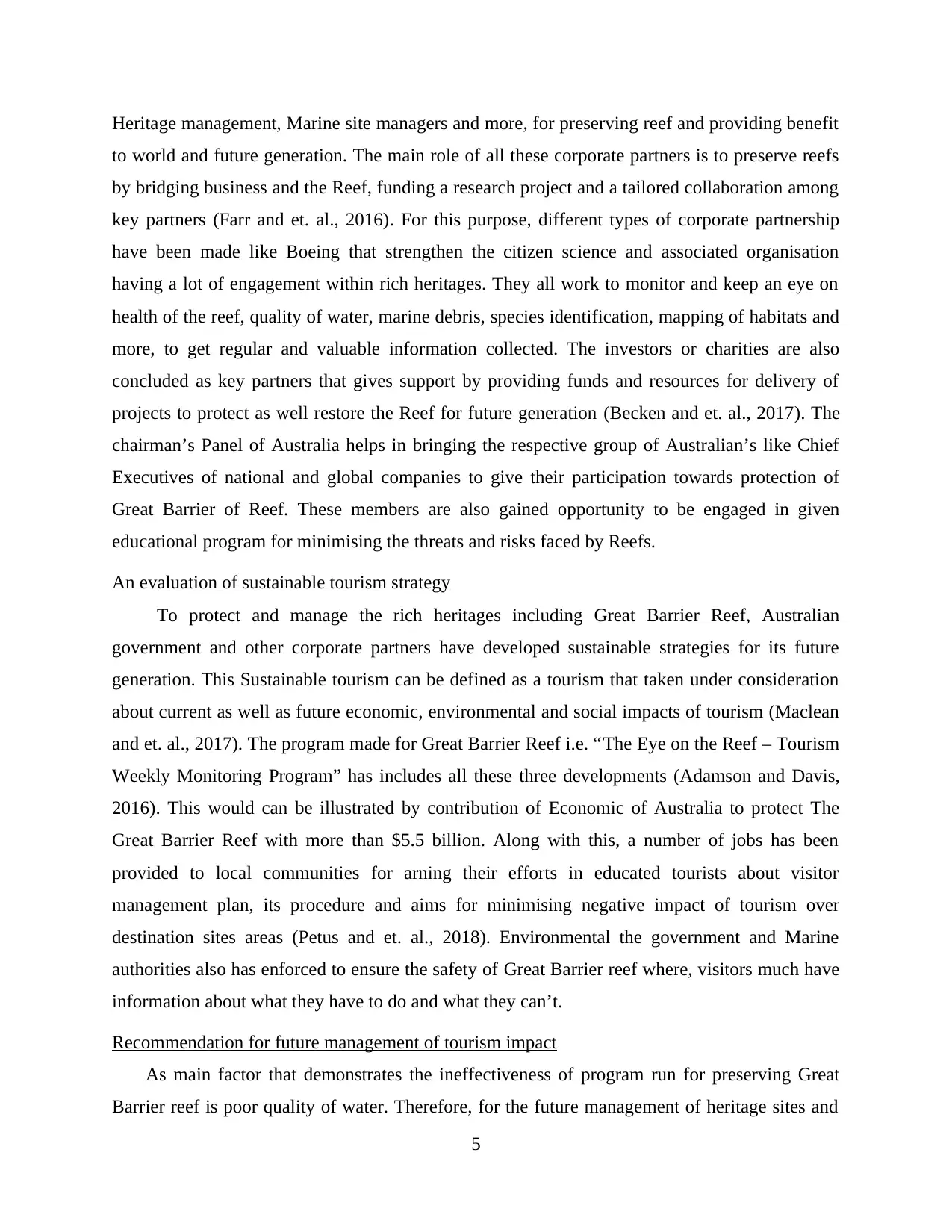
Heritage management, Marine site managers and more, for preserving reef and providing benefit
to world and future generation. The main role of all these corporate partners is to preserve reefs
by bridging business and the Reef, funding a research project and a tailored collaboration among
key partners (Farr and et. al., 2016). For this purpose, different types of corporate partnership
have been made like Boeing that strengthen the citizen science and associated organisation
having a lot of engagement within rich heritages. They all work to monitor and keep an eye on
health of the reef, quality of water, marine debris, species identification, mapping of habitats and
more, to get regular and valuable information collected. The investors or charities are also
concluded as key partners that gives support by providing funds and resources for delivery of
projects to protect as well restore the Reef for future generation (Becken and et. al., 2017). The
chairman’s Panel of Australia helps in bringing the respective group of Australian’s like Chief
Executives of national and global companies to give their participation towards protection of
Great Barrier of Reef. These members are also gained opportunity to be engaged in given
educational program for minimising the threats and risks faced by Reefs.
An evaluation of sustainable tourism strategy
To protect and manage the rich heritages including Great Barrier Reef, Australian
government and other corporate partners have developed sustainable strategies for its future
generation. This Sustainable tourism can be defined as a tourism that taken under consideration
about current as well as future economic, environmental and social impacts of tourism (Maclean
and et. al., 2017). The program made for Great Barrier Reef i.e. “The Eye on the Reef – Tourism
Weekly Monitoring Program” has includes all these three developments (Adamson and Davis,
2016). This would can be illustrated by contribution of Economic of Australia to protect The
Great Barrier Reef with more than $5.5 billion. Along with this, a number of jobs has been
provided to local communities for arning their efforts in educated tourists about visitor
management plan, its procedure and aims for minimising negative impact of tourism over
destination sites areas (Petus and et. al., 2018). Environmental the government and Marine
authorities also has enforced to ensure the safety of Great Barrier reef where, visitors much have
information about what they have to do and what they can’t.
Recommendation for future management of tourism impact
As main factor that demonstrates the ineffectiveness of program run for preserving Great
Barrier reef is poor quality of water. Therefore, for the future management of heritage sites and
5
to world and future generation. The main role of all these corporate partners is to preserve reefs
by bridging business and the Reef, funding a research project and a tailored collaboration among
key partners (Farr and et. al., 2016). For this purpose, different types of corporate partnership
have been made like Boeing that strengthen the citizen science and associated organisation
having a lot of engagement within rich heritages. They all work to monitor and keep an eye on
health of the reef, quality of water, marine debris, species identification, mapping of habitats and
more, to get regular and valuable information collected. The investors or charities are also
concluded as key partners that gives support by providing funds and resources for delivery of
projects to protect as well restore the Reef for future generation (Becken and et. al., 2017). The
chairman’s Panel of Australia helps in bringing the respective group of Australian’s like Chief
Executives of national and global companies to give their participation towards protection of
Great Barrier of Reef. These members are also gained opportunity to be engaged in given
educational program for minimising the threats and risks faced by Reefs.
An evaluation of sustainable tourism strategy
To protect and manage the rich heritages including Great Barrier Reef, Australian
government and other corporate partners have developed sustainable strategies for its future
generation. This Sustainable tourism can be defined as a tourism that taken under consideration
about current as well as future economic, environmental and social impacts of tourism (Maclean
and et. al., 2017). The program made for Great Barrier Reef i.e. “The Eye on the Reef – Tourism
Weekly Monitoring Program” has includes all these three developments (Adamson and Davis,
2016). This would can be illustrated by contribution of Economic of Australia to protect The
Great Barrier Reef with more than $5.5 billion. Along with this, a number of jobs has been
provided to local communities for arning their efforts in educated tourists about visitor
management plan, its procedure and aims for minimising negative impact of tourism over
destination sites areas (Petus and et. al., 2018). Environmental the government and Marine
authorities also has enforced to ensure the safety of Great Barrier reef where, visitors much have
information about what they have to do and what they can’t.
Recommendation for future management of tourism impact
As main factor that demonstrates the ineffectiveness of program run for preserving Great
Barrier reef is poor quality of water. Therefore, for the future management of heritage sites and
5
Paraphrase This Document
Need a fresh take? Get an instant paraphrase of this document with our AI Paraphraser
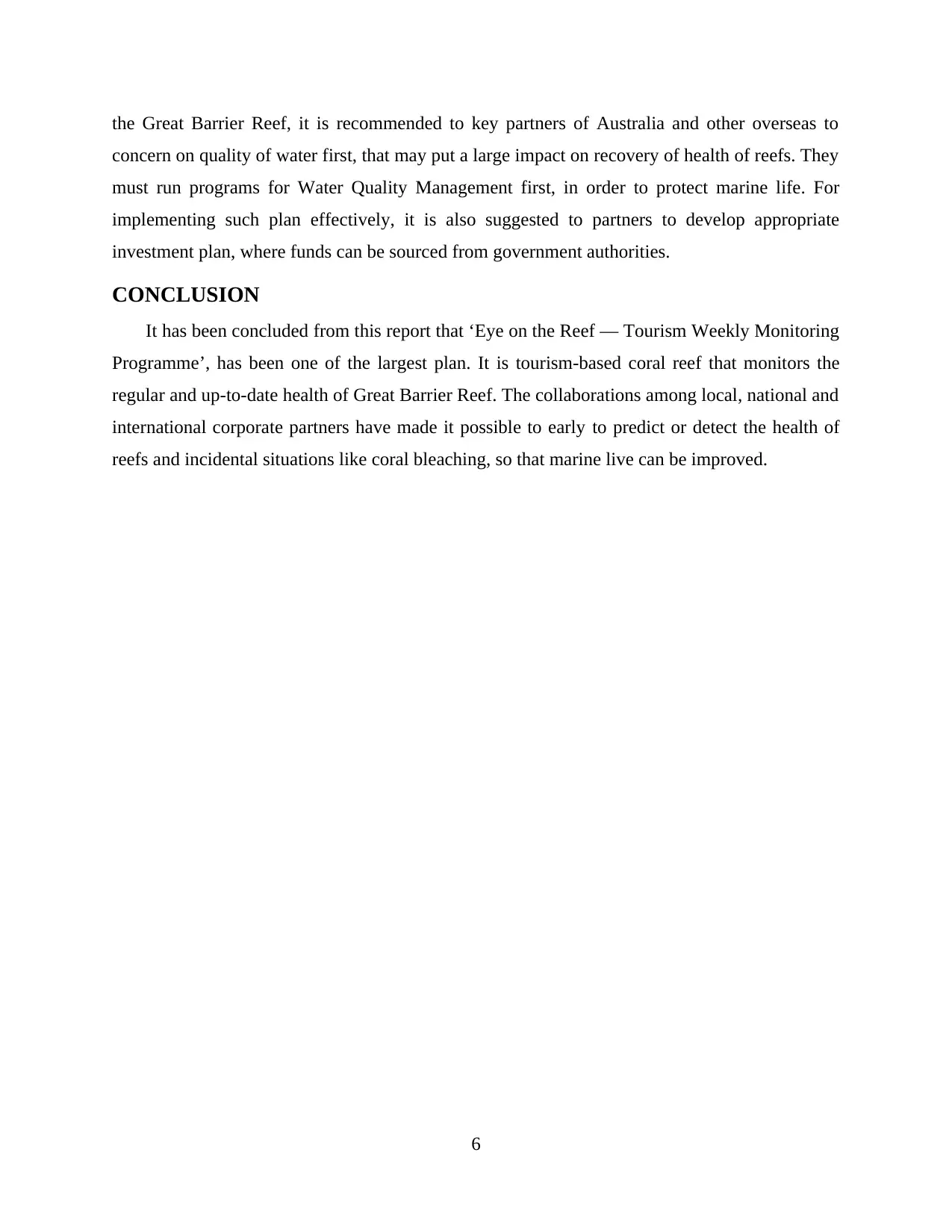
the Great Barrier Reef, it is recommended to key partners of Australia and other overseas to
concern on quality of water first, that may put a large impact on recovery of health of reefs. They
must run programs for Water Quality Management first, in order to protect marine life. For
implementing such plan effectively, it is also suggested to partners to develop appropriate
investment plan, where funds can be sourced from government authorities.
CONCLUSION
It has been concluded from this report that ‘Eye on the Reef — Tourism Weekly Monitoring
Programme’, has been one of the largest plan. It is tourism-based coral reef that monitors the
regular and up-to-date health of Great Barrier Reef. The collaborations among local, national and
international corporate partners have made it possible to early to predict or detect the health of
reefs and incidental situations like coral bleaching, so that marine live can be improved.
6
concern on quality of water first, that may put a large impact on recovery of health of reefs. They
must run programs for Water Quality Management first, in order to protect marine life. For
implementing such plan effectively, it is also suggested to partners to develop appropriate
investment plan, where funds can be sourced from government authorities.
CONCLUSION
It has been concluded from this report that ‘Eye on the Reef — Tourism Weekly Monitoring
Programme’, has been one of the largest plan. It is tourism-based coral reef that monitors the
regular and up-to-date health of Great Barrier Reef. The collaborations among local, national and
international corporate partners have made it possible to early to predict or detect the health of
reefs and incidental situations like coral bleaching, so that marine live can be improved.
6
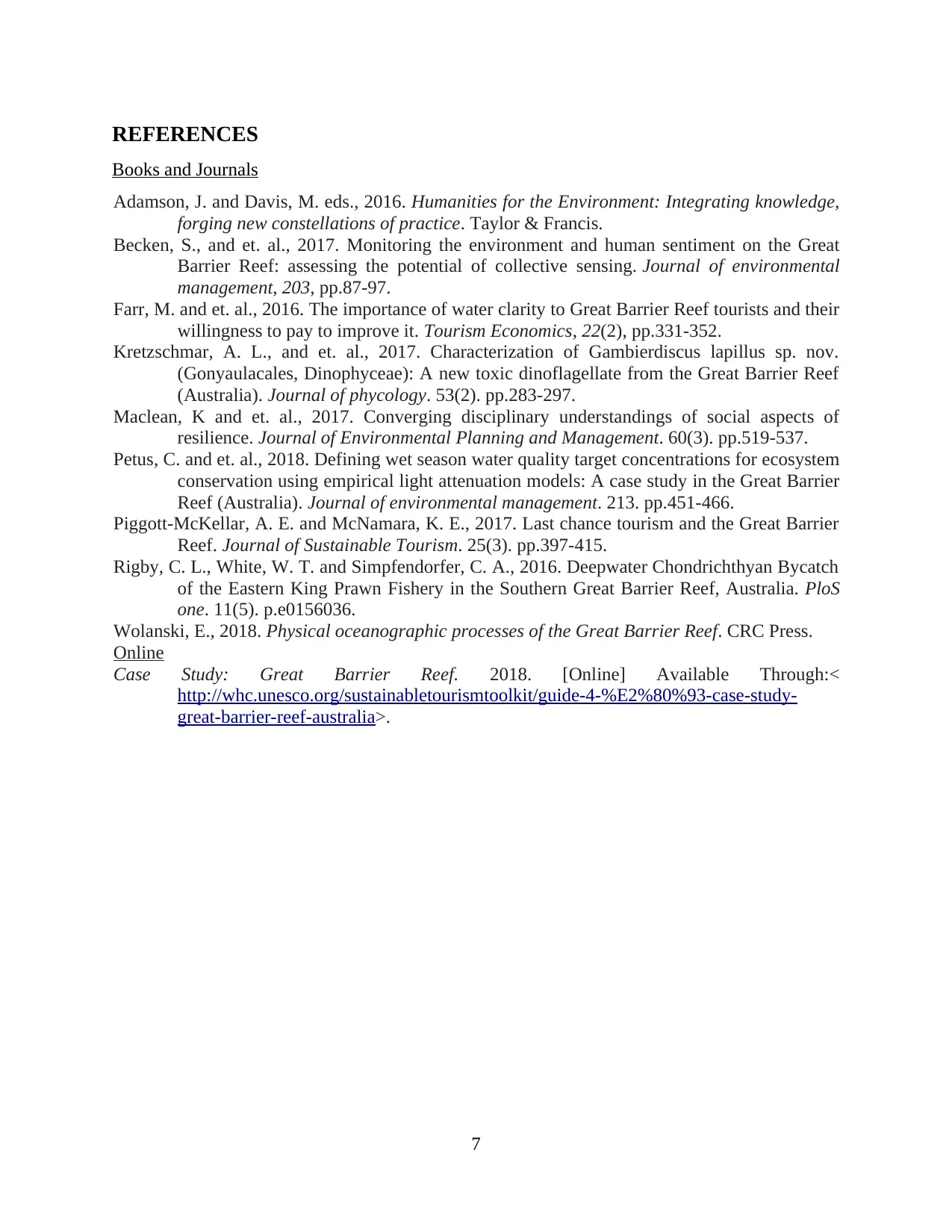
REFERENCES
Books and Journals
Adamson, J. and Davis, M. eds., 2016. Humanities for the Environment: Integrating knowledge,
forging new constellations of practice. Taylor & Francis.
Becken, S., and et. al., 2017. Monitoring the environment and human sentiment on the Great
Barrier Reef: assessing the potential of collective sensing. Journal of environmental
management, 203, pp.87-97.
Farr, M. and et. al., 2016. The importance of water clarity to Great Barrier Reef tourists and their
willingness to pay to improve it. Tourism Economics, 22(2), pp.331-352.
Kretzschmar, A. L., and et. al., 2017. Characterization of Gambierdiscus lapillus sp. nov.
(Gonyaulacales, Dinophyceae): A new toxic dinoflagellate from the Great Barrier Reef
(Australia). Journal of phycology. 53(2). pp.283-297.
Maclean, K and et. al., 2017. Converging disciplinary understandings of social aspects of
resilience. Journal of Environmental Planning and Management. 60(3). pp.519-537.
Petus, C. and et. al., 2018. Defining wet season water quality target concentrations for ecosystem
conservation using empirical light attenuation models: A case study in the Great Barrier
Reef (Australia). Journal of environmental management. 213. pp.451-466.
Piggott-McKellar, A. E. and McNamara, K. E., 2017. Last chance tourism and the Great Barrier
Reef. Journal of Sustainable Tourism. 25(3). pp.397-415.
Rigby, C. L., White, W. T. and Simpfendorfer, C. A., 2016. Deepwater Chondrichthyan Bycatch
of the Eastern King Prawn Fishery in the Southern Great Barrier Reef, Australia. PloS
one. 11(5). p.e0156036.
Wolanski, E., 2018. Physical oceanographic processes of the Great Barrier Reef. CRC Press.
Online
Case Study: Great Barrier Reef. 2018. [Online] Available Through:<
http://whc.unesco.org/sustainabletourismtoolkit/guide-4-%E2%80%93-case-study-
great-barrier-reef-australia>.
7
Books and Journals
Adamson, J. and Davis, M. eds., 2016. Humanities for the Environment: Integrating knowledge,
forging new constellations of practice. Taylor & Francis.
Becken, S., and et. al., 2017. Monitoring the environment and human sentiment on the Great
Barrier Reef: assessing the potential of collective sensing. Journal of environmental
management, 203, pp.87-97.
Farr, M. and et. al., 2016. The importance of water clarity to Great Barrier Reef tourists and their
willingness to pay to improve it. Tourism Economics, 22(2), pp.331-352.
Kretzschmar, A. L., and et. al., 2017. Characterization of Gambierdiscus lapillus sp. nov.
(Gonyaulacales, Dinophyceae): A new toxic dinoflagellate from the Great Barrier Reef
(Australia). Journal of phycology. 53(2). pp.283-297.
Maclean, K and et. al., 2017. Converging disciplinary understandings of social aspects of
resilience. Journal of Environmental Planning and Management. 60(3). pp.519-537.
Petus, C. and et. al., 2018. Defining wet season water quality target concentrations for ecosystem
conservation using empirical light attenuation models: A case study in the Great Barrier
Reef (Australia). Journal of environmental management. 213. pp.451-466.
Piggott-McKellar, A. E. and McNamara, K. E., 2017. Last chance tourism and the Great Barrier
Reef. Journal of Sustainable Tourism. 25(3). pp.397-415.
Rigby, C. L., White, W. T. and Simpfendorfer, C. A., 2016. Deepwater Chondrichthyan Bycatch
of the Eastern King Prawn Fishery in the Southern Great Barrier Reef, Australia. PloS
one. 11(5). p.e0156036.
Wolanski, E., 2018. Physical oceanographic processes of the Great Barrier Reef. CRC Press.
Online
Case Study: Great Barrier Reef. 2018. [Online] Available Through:<
http://whc.unesco.org/sustainabletourismtoolkit/guide-4-%E2%80%93-case-study-
great-barrier-reef-australia>.
7
1 out of 9
Related Documents
Your All-in-One AI-Powered Toolkit for Academic Success.
+13062052269
info@desklib.com
Available 24*7 on WhatsApp / Email
![[object Object]](/_next/static/media/star-bottom.7253800d.svg)
Unlock your academic potential
© 2024 | Zucol Services PVT LTD | All rights reserved.





